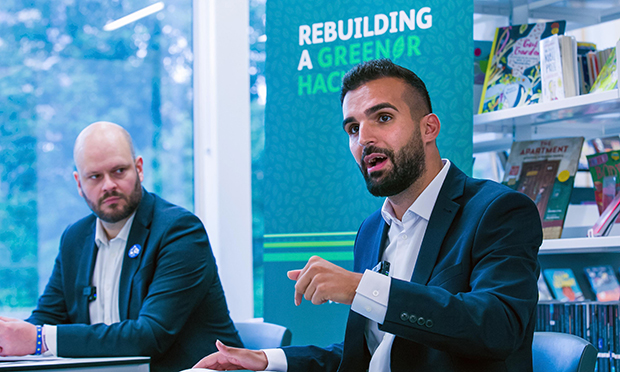‘Medievalism’: Campaigners bristle as Hackney’s transport boss puts borough forward for road pricing pilot

Hackney’s transport boss Cllr Mete Coban (right) with Mayor Philip Glanville. Photograph: Hackney Council
Hackney’s transport boss has signalled a willingness to make the borough a pilot area for road pricing in London – as part of efforts to help reverse climate change.
Cllr Mete Coban told an audience at a recent council-backed walking and cycling conference that “affordable road user charging” is the next step to drive down traffic.
He told green transport experts that measures such as low traffic neighbourhoods (LTNs) and school streets play a huge role in cutting harmful carbon emmisions.
The Labour-controlled council wants Hackney to be “the most walking- and cycle-friendly borough in London, leading the push to build people-focused neighbourhoods with cleaner air and healthier lives”.
It pledged to do a feasability study and impact assessment of road user charging as part of its climate action plan.
Cllr Coban told the conference he hoped Hackney could be a pioneer, adding: “We have started to look at how it could work in the borough.”
He explained that on some local streets, there are no further moves that can be made to cut traffic .
Just 30 per cent of residents own a car and Town Hall experts say most traffic comes from outside the borough.
Cllr Coban said: “There are certain parts of the borough where we will have to think about road user charging.”
He added: “We are happy for Hackney to be a pilot borough and set an example for London.”
Council insiders said any scheme would have to be approved by the government, so it could take several years if it gets the green light.
In a response to Sadiq Khan’s consultation on the expansion of the capital’s ultra low emission zone (ULEZ) last year, Hackney Mayor Philip Glanville and Cllr Coban wrote that they wanted to “highlight the case for significant traffic reduction through road user charging and put Hackney forward as a lead local authority in any future pilot projects”.
They continued: “Stricter controls are also needed to tackle harmful pollution from particulates (PM2.5 and PM10) which cannot be fully addressed through reducing tailpipe emissions, but need to be linked to road traffic reduction.”
They said “the pace of change needs to be much faster” for distance-based road user charging, adding: “This is especially important in the context of the acknowledged need to reduce traffic in London by 27 per cent by the end of the decade.
“We support the use of such a scheme to achieve a ‘just transition’ to a net-zero carbon in London by 2030.”
Niall Crowley from Free Our Streets, a group of north and east London residents and business owners who campaigned against the introduction of LTNs during lockdown, branded the move “a kind of medievalism”.
He said: “It is no surprise to us that Hackney Council is actively seeking ways to introduce road user charging.
“It’s like taking another step backwards towards a kind of medievalism, with our city carved up into a patchwork of authorities who police and tax our movements.
“Hackney Council’s idea of ‘public service’ now is to block and restrict. They have nothing positive or creative to offer and road charging, like LTNs, will increase the burden on residents and local businesses.
“It seems likely that Hackney’s so-called ‘boundary roads’, where traffic is up by as much as 55 per cent since the introduction of LTNs, are to become the new toll roads, bringing in revenue for the Town Hall but only permanent misery for residents.
“Road charging gives lie to the claim that the council is interested in tackling pollution and improving our environment and our neighbourhoods.”
Green councillor Zoe Garbett said: “We see pay-as-you-drive as a much fairer model of road user charging. Greens in City Hall have been leading the conversation around this, and making sure that issues are ironed out like ensuring the schemes are privacy-friendly.
“This model of road user charging is a more equitable way for transiting to more sustainable modes of transport – but must be coupled with improvements to make cycling, walking and wheeling the most safe and pleasant option for residents.”
